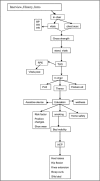A Cardiopulmonary Instructor's Perspective on a Standardized Patient Experience: Implications for Cardiopulmonary Physical Therapy Education
- PMID: 21886477
- PMCID: PMC3163414
A Cardiopulmonary Instructor's Perspective on a Standardized Patient Experience: Implications for Cardiopulmonary Physical Therapy Education
Abstract
Purpose: Standardized patients (SP) in Doctor of Physical Therapy (DPT) curricula are increasingly used for students to practice developing clinical reasoning, communication, and professional skills in an authentic learning environment. The purposes of this article are to: (1) describe an instructional model that synthesized SPs, Internet-based communities of practice, and reflection to teach clinical reasoning in DPT students; and (2) a cardiovascular and pulmonary physical therapy (CPPT) instructor's perspective on the educational process and student clinical skill development.
Summary of key points: The model, employed in a course: "Integrative Physical Therapy Practice," enabled the instructor to document student clinical performance and reasoning during an SP interaction. For students, clinical reasoning was illuminated through the model's assessment process. Data collected through the assessment process provided important feedback to the instructor on classroom instructional effectiveness.
Conclusions: Examination of student learning experiences enabled the instructor to consider: (1) key aspects of examination and management for persons with cardiovascular or pulmonary disorders, (2) methods for visualizing clinical reasoning, (3) the impact of teaching on student learning, and (4) strategies for teaching CPPT. More research is indicated to investigate pedagogy for the development of clinical reasoning in DPT students.
Keywords: cardiovascular; clinical reasoning; physical therapy education; pulmonary; reflection; standardized patient.
Figures
Similar articles
-
Student and educator experiences of maternal-child simulation-based learning: a systematic review of qualitative evidence protocol.JBI Database System Rev Implement Rep. 2015 Jan;13(1):14-26. doi: 10.11124/jbisrir-2015-1694. JBI Database System Rev Implement Rep. 2015. PMID: 26447004
-
The Instructor's Role in a Model-Based Inquiry Laboratory: Characterizing Instructor Supports and Intentions in Teaching Authentic Scientific Practices.CBE Life Sci Educ. 2022 Mar;21(1):ar9. doi: 10.1187/cbe.21-07-0177. CBE Life Sci Educ. 2022. PMID: 35119949 Free PMC article.
-
Impact of an instructional team's feedback on an instructor's teaching practices in a Biology of Cancer course.Biochem Mol Biol Educ. 2024 Nov-Dec;52(6):621-632. doi: 10.1002/bmb.21850. Epub 2024 Jul 17. Biochem Mol Biol Educ. 2024. PMID: 39016084
-
Developing clinical reasoning in the classroom - analysis of the 4C/ID-model.Eur J Dent Educ. 2015 May;19(2):74-80. doi: 10.1111/eje.12105. Epub 2014 May 9. Eur J Dent Educ. 2015. PMID: 24810116 Review.
-
Promoting cognitive and metacognitive reflective reasoning skills in nursing practice: self-regulated learning theory.J Adv Nurs. 2004 Feb;45(4):381-91. doi: 10.1046/j.1365-2648.2003.02921.x. J Adv Nurs. 2004. PMID: 14756832 Review.
Cited by
-
Simulation Experiences in Canadian Physiotherapy Programmes: A Description of Current Practices.Physiother Can. 2018 Summer;70(3):262-271. doi: 10.3138/ptc.2017-11.e. Physiother Can. 2018. PMID: 30275651 Free PMC article.
References
-
- American Physical Therapy Association . Guide to Physical Therapy Practice. 2nd ed. Alexandria, VA: American Physical Therapy Association; 2003.
-
- American Physical Therapy Association Web site. APTA Vision Statement for Physical Therapy 2020. http://www.apta.org/Vision2020/ Accessed May 17, 2011.
-
- Jones MA. Clinical reasoning in manual therapy. Phys Ther. 1992;72(12):875–884. - PubMed
-
- Babyar SR, Pivko S, Rosen E. Pedagogical tools to develop clinical reasoning: Physical therapy students' perspective. J Allied Health. 2010;39(1):e-97–104. - PubMed
LinkOut - more resources
Full Text Sources
Research Materials




